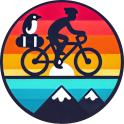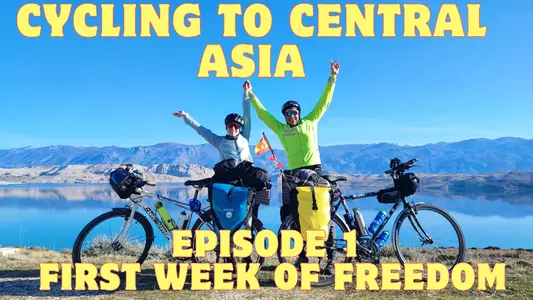Our bikepacking adventure towards Central Asia (and beyond!) has just begun! Well… actually it began a few months ago, but you know, I have been busy travelling and hacking around. So let’s imagine that it just began ![]()
We would like to share our journey with everyone, and we will be releasing a lot of content along the way: pictures, blog posts… and even a YouTube series! Although we have big limitations like the lack of time (we are releasing the series while cycling to keep it fresh and up-to-date) and the complete absence of proper recording devices (just my smartphone and earplugs!), we have tried to offer you something interesting and entertaining that will make you feel part of our adventure, and maybe motivate to start your own one day! The first episode is already available, we hope you will enjoy it!
Content:
- 1. First destination: Italy… on a train?
- 2. Crossing Slovenia and entering Croatia
- 3. Island Hopping
- 4. The other Adriatic Pearls
1. First destination: Italy… on a train?
Many bikepacking adventures start from the doorstep, and that usually makes sense: it represents the act of leaving home and starting your journey towards the unknown. Not only that, it is easier and cheaper than transporting your bike and the bags on a train/bus/ferry/plane. But in our case, that would have meant spending at least one week in a region we have cycled a lot (we often cycle around with our city/mountain/road bikes), instead of investing that time in places we don’t know. Unfortunately, we have a deadline we should not miss: we have agreed to come back to our current jobs in one year. Therefore, every week we spend doing “normal” stuff is a week we won’t live new adventures. Not only that, starting in the middle of the Alps where we live would have implied freezing day and night and crossing challenging passes, maybe covered in snow. We are looking forward to living adventures, but not to suffering on roads we have enjoyed for years under better conditions.
Although making the decision that we would first take a train was easy, choosing the destination was not. We thought about starting in Austria, either in Innsbruck or near Slovenia, crossing some part of the Italian Alps (we are in love with South Tirol), or getting a bit further to Ljubljana or even Zagreb. In the end, we found a good connection to Trieste, which would allow us to start in Italy in a city we didn’t know to then climb from the sea level to cross Slovenia and reach Croatia.
Trieste is a nice city with a couple of places worth passing by. But what we really liked more than anything else was the hosts we have via BeWelcome (Marzio and his family), and the former railway towards Slovenia, now an unpaved cycle lane called Giordano Cottur Walking & Cycling Path, which was the official start of our cycling adventure.
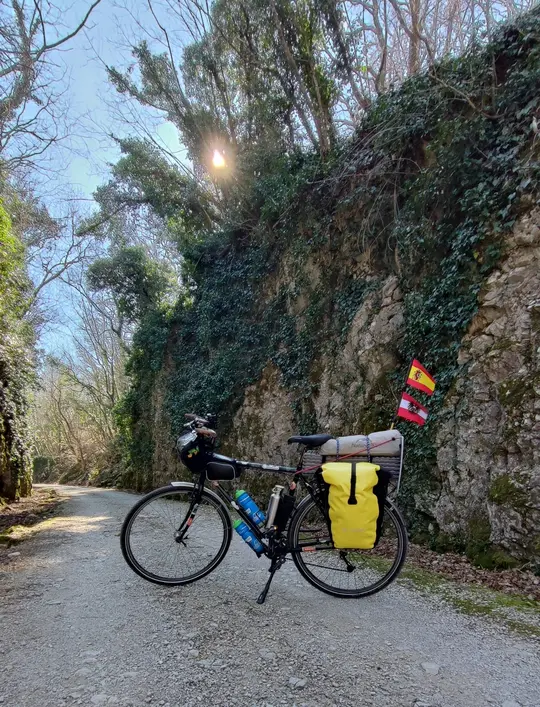
2. Crossing Slovenia and entering Croatia
We entered Slovenia without noticing, as the path continues without clear signs of having reached another country, but still requiring some effort to climb ~800m in a few kilometers. The part we cycled in Slovenia is very quiet, as the roads have almost no traffic, and the villages are very small. We mixed paved and unpaved roads on our way towards Croatia, which we reached in the same day.
Actually, you only have to cycle for X km to cross this part of Slovenia, and we didn’t want to start with detours so soon, as this area is easy to reach from home. Obviously, we can’t just judge the country for the tiny portion we saw, but on the other hand, I have been a couple of times in Slovenia before. It’s an incredibly beautiful country that has a bit of everything, especially for nature lovers: mountains (the Julian Alps), lakes (like Bled and Bohinj), and many, many caves (e.g. Postojna, close to the Predjama castle, and my favorite, Škocjan), which is not far from the route, are absolutely mind-blowing! If you are just cycling around Europe or willing to spend more time in this region, you will definitely not regret spending a couple of days longer in Slovenia.
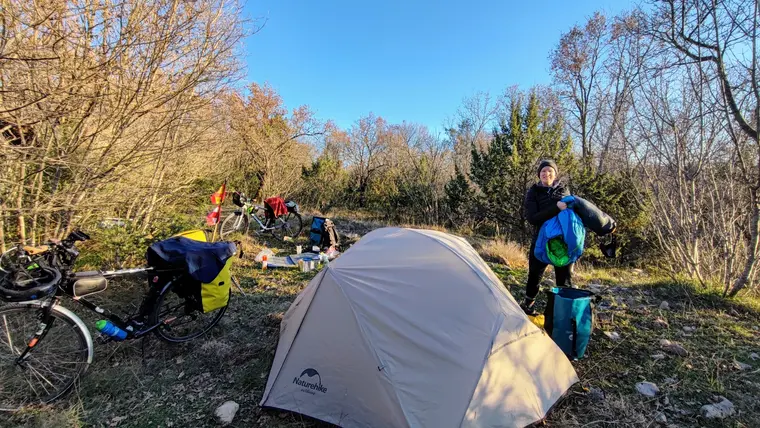
Entering Croatia was just slightly more noticeable, as we crossed a border were there was no one controlling it. If you don’t live in the European Union, you might find this weird, but here it is, fortunately!, pretty common. The roads were still empty and the villages even smaller, some of them partially abandoned. That always makes finding a camping spot easier, and we continued cycling until it started to get darker (still at around 5:30 pm), only to find out that the forest was much wilder there, so we ended up pinching the tent in a rather wild field that had “signs” of the local fauna. Moreover, we were at the top of a hill and the night was pretty cold, and although it was manageable, we learnt that cycling down to warmer places is usually worth it, even if it’s a bit late. We have had much better places to sleep along the way, but for the first night we did alright!
3. Island Hopping
Cycling along the Croatian coast has pros and cons: the views to the sea and the numerous islands is stunning, but there is usually a single road with more traffic than bikepackers like. Although we didn’t want to slow down in the early stages of the trip, we decided to mix some parts of the continental coast with a bit of island hopping, and the result was in our opinion very positive.
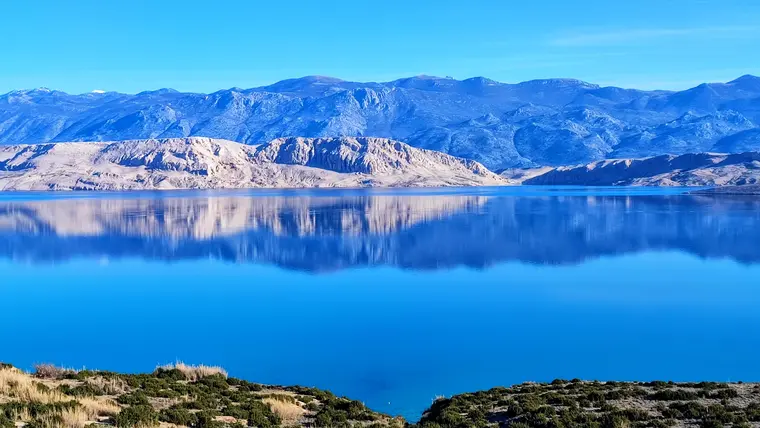
After cycling down from our campsite to Rijeka, we enjoyed some roads with scenic views before leaving the main road to reach the first island (Krk, connected to the dryland by a bridge), where we cycled off-road on easy terrain to avoid the unexpected heavy traffic. From there, we took a ferry to Rab (all ferries cost around €6 with the bike, ~50% more expensive in the summer), a more quiet island with scenic views to the sea and the town the island takes its name from. Just cycle up the central hills (they are not very high) instead of cycling on the main road, and if you have time, cycle down to the cute-looking town. There are ferries from there to Pag (the next island, actually a peninsula connected to the surroundings of Zadar on the other end) around twice a week, but not the day we arrived, and it was still early anyway. We crossed the whole island to catch another ferry back to the continental coast and continued cycling on a very beautiful road that made us forget the ferry we didn’t took in a few minutes. We climbed from the port to the plateau that offer such awesome views, and cycled down again to take yet another ferry, this time to Pag, the last one in Croatia… but as you will see, by no means the last one of the trip! This time we found a beautiful place to camp by the sea, where we enjoyed both a beautiful sunset and sunrise the next day.
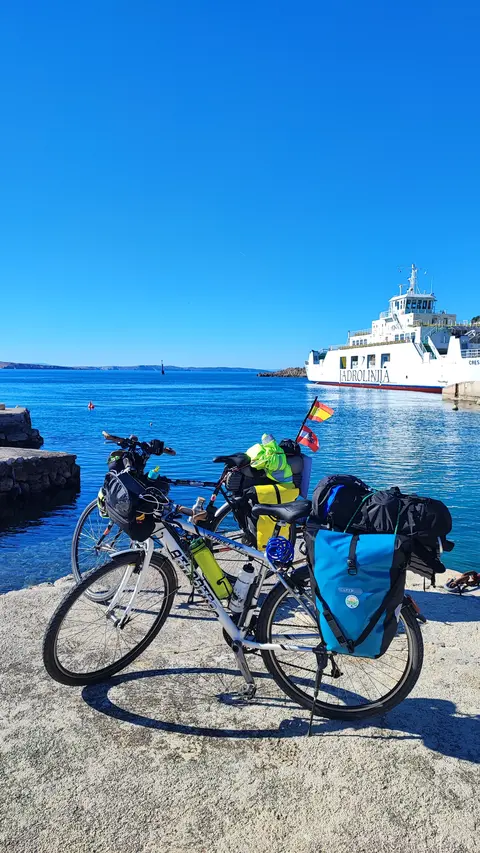
4. The other Adriatic Pearls
Crossing Pag towards Zadar could be split into two different sections: the first one from the ferry to the end of the peninsula, and the second one from that point to Zadar. The former is incredibly beautiful and fun to cycle as long as you take alternative, not completely paved roads (see the map). Actually, the picture I chose for the video thumbnail was taken somewhere within that section. You will meet almost no one until the town of Pag (we only met a man training for an Iron Man), and not many more afterward until the point where you will join the main road. The latter is not that beautiful and more annoying due to the higher traffic and relatively steep slopes. Although some part of it belongs to the Euro Velo 8, it is an uninteresting section that you should cover as fast as possible to reach Zadar.
Zadar is the first of a series of cities that I call “the other” Adriatic Pearls. The Adriatic Pearl is a common nickname for Dubrovnik, and although it is indeed one of the must-sees in Croatia, in my opinion it is too touristy, and it has received all the attraction that other Croatian towns would have also deserved. For me, these towns are Zadar, Trogir, Sibenik, and Split, being Split my personal favorite followed by Trogir.
All these towns share some things with Dubrovnik: the architecture, the predominance of the white color, and walkable centers with narrow streets. You will cycle near all of them if you follow the coast as we did, and you will only short detours to visit the old town of every one of them. We did so, and also cycled their narrow streets as you will see on the video. The center of these towns is rather small (the one in Zadar is a bit bigger, but still small enough to cycle end-to-end quickly), so you will not lose much time visiting them unless you fall in love with one of them and decide to call it a day ![]()
After spending one night in Zadar in an apartment we booked on Booking.com (Aldo Apartments Center) to (partially) recover from the first days of cycling, we continued towards my beloved Split following the coast, that once again is not as flat as you would imagine. Sometimes we followed the famous, sometimes overrated Euro Velo 8, and sometimes we took paths that we thought that would be more interesting. I would like to mention here that we always plan our own route without blindly following what other cyclists did in the past. We like planning our route because we learn a lot about the regions we are going to cross during the process, and we also like having a unique route (more or less, some parts are so obvious that everyone follows the same route) instead of relying on what Komoot or similar apps offer: a slightly guided tour. That takes time of course, and I am not saying that our approach is better, it’s just ours. But if you don’t like planning or don’t have time for it, feel free to follow our route or any other you found on your favorite app/website.
Anyway, after a short stop in Trogir to eat something and cycle around the center and the boulevard by the sea, we continued our way up to Sibenik, whose cathedral is a UNESCO World Heritage Site. To be honest, I visited Sibenik many years ago and the cathedral was fine, but not otherworldly, so we didn’t visit it this time: we cycled around the center again, saw the cathedral from the outside, drank some coffee, and looked for a nice place to pinch the tent on a hill nearby close to a small church.
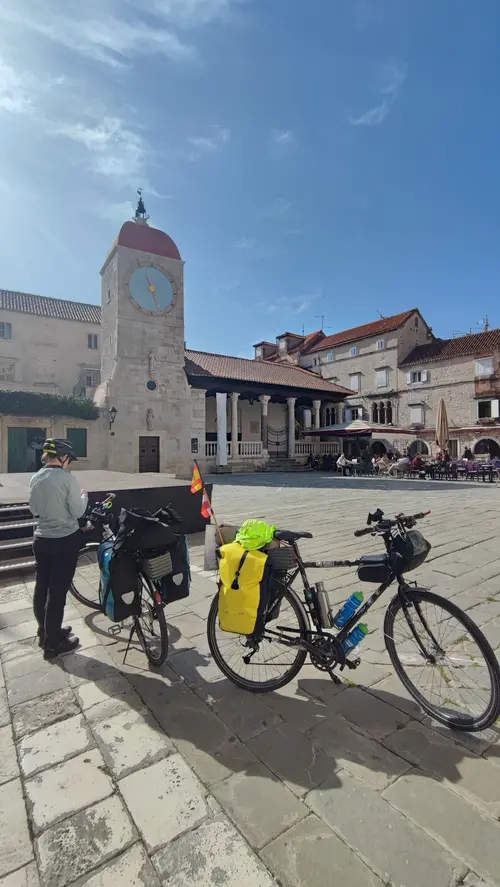
The last day of this first week of freedom consisted of climbing the hill that separated us from Split, reaching the town in the afternoon after crossing its industrial and residential area, which has heavy traffic but can be covered rather quickly. Even though we had had half a day in Zadar to recover, we needed a longer break and Split was the perfect location for a two-night recovery: good weather, lots of food, and a wonderful city center, mainly contained within the former palace of the Roman emperor Diocletian. Although Split is more touristic than the previous pearls, it’s still manageable (at least off the high season), and I would really recommend you not to skip it if you cycle/driver nearby.
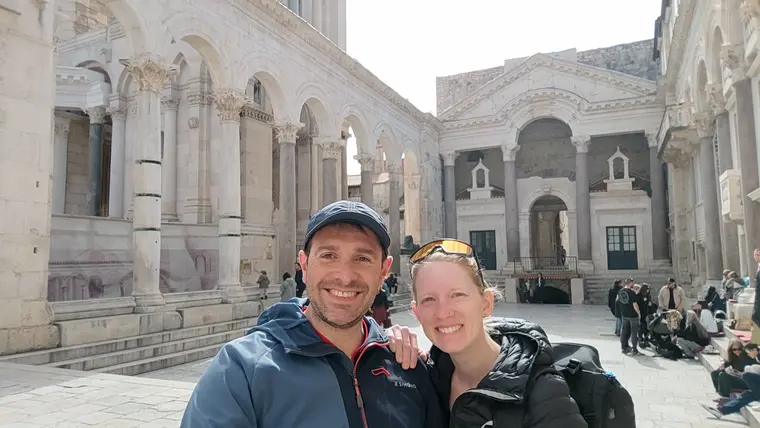
And that’s enough for the first week of our adventure, stayed tuned for the next episodes!
